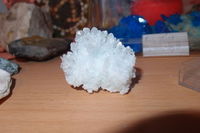Ammonium chloride
 |
This article is a stub. Please help Sciencemadness Wiki by expanding it, adding pictures, and improving existing text.
|

| |
| Names | |
|---|---|
| IUPAC name
Ammonium chloride
| |
| Systematic IUPAC name
Ammonium chloride | |
| Other names
Sal ammoniac
Salmiac | |
| Except where otherwise noted, data are given for materials in their standard state (at 25 °C [77 °F], 100 kPa). | |
| Infobox references | |
Ammonium chloride is an inorganic compound with the formula NH4Cl. It's white crystalline solid, highly soluble in water.Solutions of ammonium chloride are mildly acidic. Ammonium chloride occurs naturaly as mineral Sal ammoniac which is commonly formed on burning coal dumps, due to condensation of coal-derived gases. It is also found around some types of volcanic vents. Ammonium chloride is mainly used as fertilizer and as flavouring agent in some types of liquorice.
Contents
[hide]Properties
Chemical
Ammonium chloride will react with sodium hydroxide to give off ammonia gas.
Physical
Ammonium chloride is a white crystalline solid, soluble in water.
Availability
Ammonium chloride is sold by various chemical suppliers.
Preparation
Reaction of hydrochloric acid with ammonia will result in ammonium chloride.
- NH3 + HCl → NH4Cl
If the reaction occurs in gaseous phase, a very fine mist of ammonium chloride will form.
Projects
- Growing crystals
- Making smoke bombs
Handling
Safety
Inhalation: Irritating to mucous membranes. Irritating to respiratory system.
Skin exposure: Repeated or prolonged exposure may cause dermatitis
Ingestion: Harmful if swallowed in large dosages. May cause nausea, vomiting and acidosis. In small dosages it can be consumed without ill effects.
Eyes contact: Irritating to eyes.
Storage
Store in a cool, dry, well ventilated place, in securely closed original container.
Disposal
Ammonium chloride solution could be poured down the drain or disposed in envniroment as fertilizer (In small quantities).